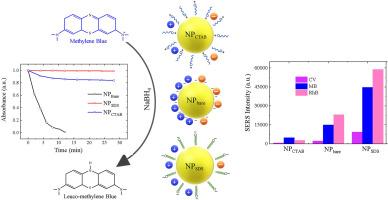Effect of surface charge on laser-produced silver nanoparticles for dye reduction and surface-enhanced Raman spectroscopy
IF 4.3
3区 材料科学
Q2 CHEMISTRY, MULTIDISCIPLINARY
引用次数: 0
Abstract
Silver nanoparticles (Ag NPs) are widely used in biological, chemical, and physical fields due to their distinct properties. However, the effect of surfactants with different polarities on the catalytic and surface-enhanced Raman spectroscopy (SERS) performance of Ag NPs has not been thoroughly studied. Here, we tailor the surface charge of laser-synthesized Ag NP without changing their morphology and investigate their catalytic and SERS capabilities. The surfactant-free silver nanoparticles (NPBare), synthesized via pulsed laser ablation in liquid (PLAL), are subsequently coated with ionic surfactants sodium dodecyl sulfate (NPSDS) and cetyltrimethylammonium bromide (NPCTAB). The synthesis and morphology of Ag NPs are confirmed using UV–Vis absorption spectroscopy and scanning electron microscopy. The surface charge of fabricated NPs is determined using zeta potential (ZP) measurements. The ZP values of NPBare, NPSDS, and NPCTAB are determined to be −17 mV, 28.7 mV, and 5.58 mV, respectively. The catalytic activity of bare and coated Ag NPs was tested against the cationic and anionic dyes, Methylene blue (MB) and Methyl orange (MO) respectively. The reduction rate of both dyes was highest when using NPBare. However, in the case of coated nanoparticles, the rate of MB and MO reduction depends on the difference between the ZP of the dye and nanoparticles: the rate of reduction increases with the difference between the zeta potentials of the dye and coated nanoparticles increases. The SERS capability of bare and coated NPs was evaluated for anionic (MO) and cationic (MB, Rhodamine B, and Crystal Violet) dyes. The SERS intensity of dyes strongly enhanced with the increase in ZP difference between the dye molecules and NPs. Surface charge modified NPs shown excellent SERS sensitivity with detection limit up to nanomolar for dye molecules as well as the homogeneity of NPs demonstrated in Raman mapping results with relative standard deviation of 17 %. The results suggest that the electrostatic interaction between the nanoparticles and dye molecules plays a dominant role in SERS enhancement. These findings highlight the significance of surface charge in improving the catalytic and sensing properties of noble metal nanoparticles.

表面电荷对用于染料还原和表面增强拉曼光谱的激光生产银纳米粒子的影响
银纳米粒子(Ag NPs)因其独特的性质被广泛应用于生物、化学和物理领域。然而,不同极性的表面活性剂对银纳米粒子的催化和表面增强拉曼光谱(SERS)性能的影响尚未得到深入研究。在此,我们在不改变激光合成的银纳米粒子形态的情况下,对其表面电荷进行了定制,并研究了它们的催化和 SERS 性能。通过液态脉冲激光烧蚀(PLAL)合成的无表面活性剂银纳米粒子(NPBare),随后涂覆了离子表面活性剂十二烷基硫酸钠(NPSDS)和十六烷基三甲基溴化铵(NPCTAB)。利用紫外-可见吸收光谱和扫描电子显微镜证实了 Ag NPs 的合成和形态。利用 zeta 电位(ZP)测量法确定了制备的 NPs 的表面电荷。NPBare、NPSDS 和 NPCTAB 的 ZP 值分别为 -17 mV、28.7 mV 和 5.58 mV。测试了裸银 NPs 和涂覆银 NPs 分别对阳离子和阴离子染料亚甲基蓝(MB)和甲基橙(MO)的催化活性。使用裸露 NPP 时,两种染料的还原率最高。然而,在使用包覆纳米粒子的情况下,MB 和 MO 的还原率取决于染料和纳米粒子的 ZP 值之差:染料和包覆纳米粒子的 ZETA 电位差越大,还原率越高。针对阴离子(MO)和阳离子(MB、罗丹明 B 和水晶紫)染料,评估了裸纳米粒子和包覆纳米粒子的 SERS 能力。染料的 SERS 强度随着染料分子与 NPs 之间 ZP 差的增加而增强。经表面电荷修饰的 NPs 表现出卓越的 SERS 灵敏度,对染料分子的检测限高达纳摩尔级,拉曼图谱结果表明 NPs 具有均匀性,相对标准偏差为 17%。结果表明,纳米粒子和染料分子之间的静电作用在 SERS 增强中起着主导作用。这些发现凸显了表面电荷在改善贵金属纳米粒子的催化和传感特性方面的重要作用。
本文章由计算机程序翻译,如有差异,请以英文原文为准。
求助全文
约1分钟内获得全文
求助全文
来源期刊
CiteScore
7.80
自引率
2.50%
发文量
605
审稿时长
40 days
期刊介绍:
The Journal of Physics and Chemistry of Solids is a well-established international medium for publication of archival research in condensed matter and materials sciences. Areas of interest broadly include experimental and theoretical research on electronic, magnetic, spectroscopic and structural properties as well as the statistical mechanics and thermodynamics of materials. The focus is on gaining physical and chemical insight into the properties and potential applications of condensed matter systems.
Within the broad scope of the journal, beyond regular contributions, the editors have identified submissions in the following areas of physics and chemistry of solids to be of special current interest to the journal:
Low-dimensional systems
Exotic states of quantum electron matter including topological phases
Energy conversion and storage
Interfaces, nanoparticles and catalysts.

 求助内容:
求助内容: 应助结果提醒方式:
应助结果提醒方式:


